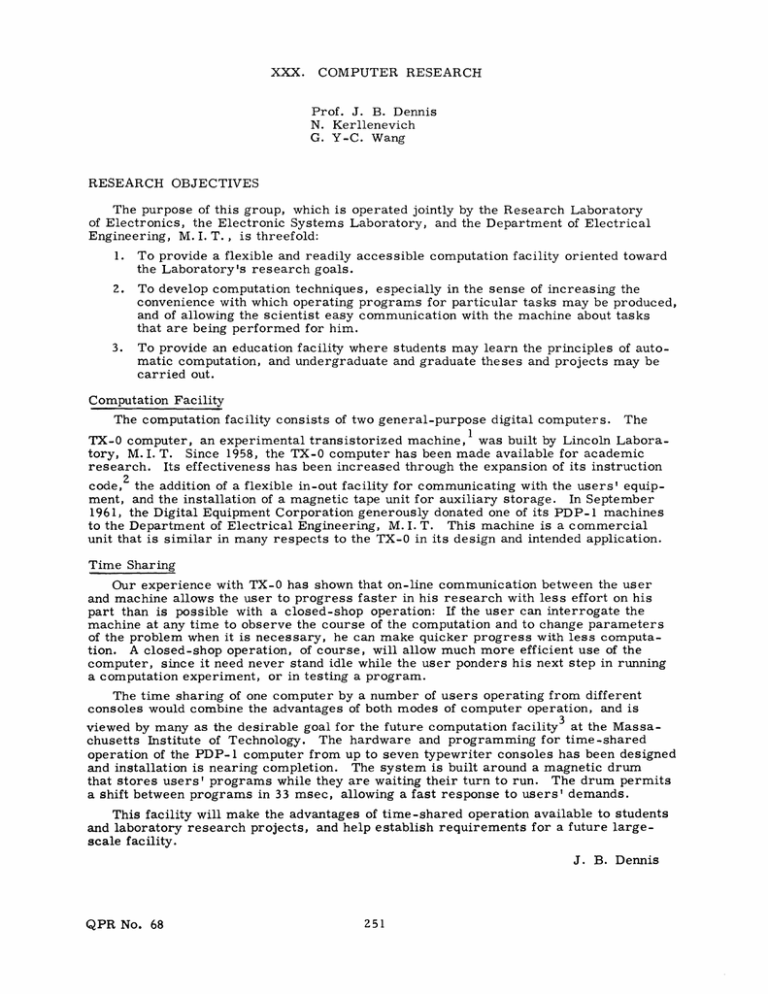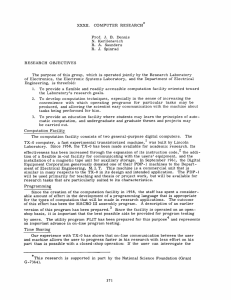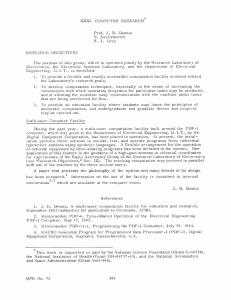MIT Computer Research: Time-Sharing & TX-0 Report
advertisement

XXX. COMPUTER RESEARCH Prof. J. B. Dennis N. Kerllenevich G. Y-C. Wang RESEARCH OBJECTIVES The purpose of this group, which is operated jointly by the Research Laboratory of Electronics, the Electronic Systems Laboratory, and the Department of Electrical Engineering, M. I. T., is threefold: 1. To provide a flexible and readily accessible computation facility oriented toward the Laboratory's research goals. 2. To develop computation techniques, especially in the sense of increasing the convenience with which operating programs for particular tasks may be produced, and of allowing the scientist easy communication with the machine about tasks that are being performed for him. 3. To provide an education facility where students may learn the principles of automatic computation, and undergraduate and graduate theses and projects may be carried out. Computation Facility The computation facility consists of two general-purpose digital computers. The TX-0 computer, an experimental transistorized machine, was built by Lincoln Laboratory, M. I. T. Since 1958, the TX-0 computer has been made available for academic research. Its effectiveness has been increased through the expansion of its instruction code, 2 the addition of a flexible in-out facility for communicating with the users' equipment, and the installation of a magnetic tape unit for auxiliary storage. In September 1961, the Digital Equipment Corporation generously donated one of its PDP-1 machines to the Department of Electrical Engineering, M. I. T. This machine is a commercial unit that is similar in many respects to the TX-0 in its design and intended application. Time Sharing Our experience with TX-0 has shown that on-line communication between the user and machine allows the user to progress faster in his research with less effort on his part than is possible with a closed-shop operation: If the user can interrogate the machine at any time to observe the course of the computation and to change parameters of the problem when it is necessary, he can make quicker progress with less computation. A closed-shop operation, of course, will allow much more efficient use of the computer, since it need never stand idle while the user ponders his next step in running a computation experiment, or in testing a program. The time sharing of one computer by a number of users operating from different consoles would combine the advantages of both modes of computer operation, and is viewed by many as the desirable goal for the future computation facility 3 at the Massachusetts Institute of Technology. The hardware and programming for time-shared operation of the PDP-1 computer from up to seven typewriter consoles has been designed and installation is nearing completion. The system is built around a magnetic drum that stores users' programs while they are waiting their turn to run. The drum permits a shift between programs in 33 msec, allowing a fast response to users' demands. This facility will make the advantages of time-shared operation available to students and laboratory research projects, and help establish requirements for a future largescale facility. J. QPR No. 68 251 B. Dennis (XXX. COMPUTER RESEARCH) References 1. J. T. Gilmore, Jr. and H. P. Peterson, A Functional Description of the TX-0 Computer, Memo 6M-4789-1, 1958. 2. Quarterly Progress Report No. 67, Research Laboratory of Electronics, M. I. T., October 15, 1962, pp. 275-282. 3. H. Teager, Report of the Long-Range Computation Study Group, M. I. T., 4. J. E. Yates, A Time Sharing System for the PDP-1 Computer, R-140, Electronic Systems Laboratory, M.I. T., June 1962. QPR No. 68 252 1961. Report ESL





